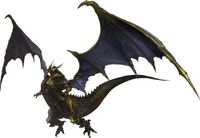Bahamut
Bahamut
- Organization
- The First Brood
- Relatives
- Tiamat (mate)
- Patch
- 2.0
Bahamut is a Primal.
- Main article: The Coils of Bahamut
Lore
“One of the first brood, Bahamut lived for countless centuries as ruler of the southern skies until being slain by the power-hungry Allagan Empire. When the dusk wyrm Tiamat learned of her beloved’s untimely fate, she, with the aid of Meracydia’s remaining dragon horde, chose to ignore the warnings of her kin and attempt a summoning of the spirit of Bahamut. Her sorrow and anguish, combined with the rage of her kin, however, corrupted the spirit as it returned from the Lifestream—the result a mad tyrant little resembling what had once been the dawn wyrm.
— Encyclopædia Eorzea vol 1, page 26
“One of the seven great wyrms, Bahamut was slain while fighting against the Allagan invasion of Meracydia. His brood-sister, Tiamat, led the surviving dragons in a summoning ritual, and their prayers resurrected the dreadwyrm as an avenging primal. A terrible incarnation of wrath and fury, Bahamut descended upon the heart of the conflict and incinerated the northern invaders with ruinous flames. He was eventually undone by the might of the anti-primal weapon, Omega, and his undying rage was sealed within the core of Dalamud. For millennia, the shackled entity’s command over flare and fire was employed to harness and store the energy of the sun.
Then came the fateful end of the Sixth Astral Era. By enthralling the mind of the Garlean legatus, Nael van Darnus, Bahamut was able to manipulate the direction of the Meteor project, and thus free himself in the skies above Carteneau. Released from the red moon after five thousand years of imprisonment, the furnace of the dreadwyrm’s vengeance immolated the lands of Eorzea, and ushered in the aether-warping devastation of the Seventh Umbral Calamity.
— Encyclopædia Eorzea vol 1, page 269
Held in duress for aeons within the lesser moon, Dalamud, the elder primal Bahamut broke free of his captivity when the celestial body was wrested from the heavens to descend upon the Battle of Carteneau. Once freed, the terrible being wrought fiery destruction across the length and breadth of Eorzea, his devastating rampage marking the beginning of the Seventh Umbral Era. In the midst of the chaos, however, Bahamut was enveloped in a blinding white light and abruptly disappeared from the skies. None claim to have seen the primal in the five years since.
“The hour is come. Receive of me the purity.”
Upon their arrival into the world so many eons ago, Bahamut chose to venture south with his kin Tiamat. The people they found there venerated the dragons, and thus a bond of friendship grew betwixt dragonkind and man. This bond was so great that scholars have reason to believe it was none other than the great wyrm himself who led the mortals of Meracydia against the invading Allagan armies, securing countless victories against their technologically advanced foes until Bahamut was ultimately slain on the field of battle, overcome by the Allagans’ godless chimeras. [1]
History
Millenia ago, during the Third Astral Era, the Allagan Empire attacked the home of the Dragons, Meracydia in an attempt to expand their territory. They used their twisted Chimeras to defeat the elder wyrm and attack the land. However, using the power of summoning, Tiamat brought Bahamut back to life, however what returned from death was but an angry shade of the former wyrm. Bahamut was able to hold off the Allagans and push them back to the shores of Meracydia, but eventually succumbed to numbers. Instead of killing him again, however, the Allagans took him and used his body as a power source, fueling their weapons and war machina.
Once the war was over, the Allagan emperor, Xande, twisted and corrupted, wished to use Bahamut as a satellite to gather fire-aspected energy from the sun. And so, Bahamut was trapped in a large metal sphere and sent into orbit, where he was used to siphon incredible amounts of energy to the Crystal Tower. But that energy caused the collapse of the Tower, the Allagan Empire as a whole, and caused the Calamity of Earth. After the fall of the Empire, Bahamut was left to circle the star, growing more and more enraged and seeking revenge.
When the Garlean Empire attempted to pull the great satellite out of the sky, Bahamut was able to break free, causing yet another great Calamity. However, Louisoix was seemingly able to trap the elder wyrm once again.
Story
As it turns out, the wyrm was not sealed away, but trapped under the earth of Carteneau, where his body fell after Louisoix managed to attack and shatter his body. It turns out the land was only able to begin healing after Louisoix relinquished the power of the Phoenix to restore the Aether to the land. The assault on Bahamut weakened Louisoix and ended up enthralling him to the wyrm.
Under the earth, Allagan technology was slowly rebuilding Bahamut, while the Ragnarok excavated deeper and deeper to find the pieces of the wyrm to rebuild its body completely. The Warrior of Light and the twins Alphinaud and Alisaie found Louisoix guarding the half-formed body of Bahamut, and he attacked them in the form of the primal Phoenix. After a climactic battle, Louisoix was able to return to his senses, express his undying love for his grandchildren, and bless them with the power of the Phoenix, hoping they would someday be able to call upon its power, then faded.
Upon finally reaching the lowest command deck, the twins were able to send the Warrior of Light's essence directly into Bahamut's heart, where they were able to finally slay the wyrm and lay him and the other enslaved Meracydians to rest after millenia of suffering.
Additional Information
- See also: wikipedia:Bahamut
Bahamut is also a server in the Japanese Gaia Data Center.
- ↑ Encyclopaedia Eorzea: Volume I, page 207
